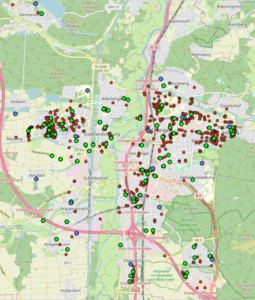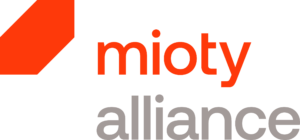Monitoring of urban water demand for city trees
Project leader: Thomas Maier
Project members: Looking for colleagues. See below.
Start date: 02.01.2022
End date: 29.03.2024
Funding source: Kommunal? Digital! – Bayern Innovativ
Abstract
This project focuses on improving the water demand for city trees. Together with the city of Erlangen the goal is to improve the current watering strategy of the city trees. In total, the city has registered over 22,000 trees that they are responsible for. Around 1,500 of these are younger than 10 years and therefore being watered on a regular basis to help with the crown and root development. Watering resources and personell are limited such that a tree can only be visited every two or three weeks. During the recent droughts in Europe and the rising temperatures in cities due to more and more asphalt surface, many trees in Erlangen unfortunately dried out and died because they were not watered in time. On the other hand some trees were watered more often than required. In order to avoid this tree loss in cities this project aims at developing a data driven recommendation algorithm for when to water which city tree. This way the more critical specimen are taken care of first. Trees with a bigger water reservoir can be watered later. The data for this approach shall be collected by 80 hardware sensing units scattered around Erlangen. They will measure the soil moisture, temperature and also percipitation at 16 sensor locations.
Sensor locations
At the bottom you can see a map indicating all positions of trees and sensors around Erlangen. The red dots represent the 1500 young trees, the green dots are measuring positions that are intended to be placed around the trees to measure soil moisture and soil temperature. On top of that the blue dots mark the positions where weather stations will be placed to measure the amount of percipitation, air temperature, humidity, pressure and solar irradiation. All sensor positions are cherry-picked and are communicated with the city department responsible for watering the trees. This way only interesting regions will be probed. The weather stations will be placed on top of public buildings that are managed by the city in order to avoid vandalism.
Data Transmission
The city of Erlangen is equipped with a fairly dense mioty® network which will be used for data transmission purposes. Developed at the Fraunhofer Institute for Integrated Circuits IIS in Erlangen and Nuremberg, the mioty® standard is a software based low-power, wide-area network (LPWAN) protocol which has the advantage of allowing much more network clients than comparable standards. This is made possible by the so-called Telegram Splitting Multiple Access (TSMA) method (ETSI TS 103 357). The data packets sent in the data stream are split into smaller packets and transmitted at separate frequencies. By doing this, a packet loss of up to 50% due to interference or bad signal strength can still be tolerated and the original message can be reassembled by a receiving gateway. Perfect for very dense networks with many clients as it is the case in smart cities with a lot of IoT devices! More information can be found on the project page of the Fraunhofer IIS or the webpage of the mioty alliance.
Participation
If this project caught your interest, feel free to contact the project leader for further information. Many options of coorporation such as Bachelor/ Master theses or student assistant jobs are possible. Helpful skills would be in the field of machine learning, weather and climate predictions, app development or route optimization algorithms.



